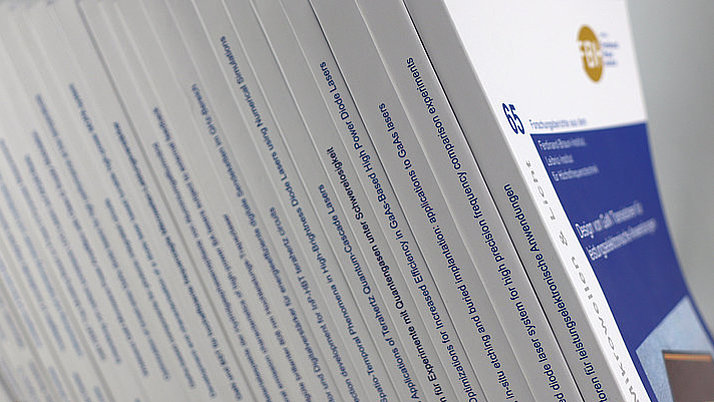Skin tolerant inactivation of multiresistant pathogens using far-UVC LEDs
J. Glaab1, N. Lobo-Ploch1,7, H.K. Cho1, T. Filler1, H. Gundlach3, M. Guttmann2, S. Hagedorn1, S.B. Lohan4, F. Mehnke2,6, J. Schleusener4, C. Sicher5, L. Sulmoni2, T. Wernicke2, L. Wittenbecher1, U. Woggon3, P. Zwicker5, A. Kramer5, M.C. Meinke4, M. Kneissl1,2, M. Weyers1, U. Winterwerber1 & S. Einfeldt1
Published in:
Sci. Rep., vol. 11, art. 14647, doi:10.1038/s41598-021-94070-2 (2021).
Abstract:
Multiresistant pathogens such as methicillin-resistant Staphylococcus aureus (MRSA) cause serious postoperative infections. A skin tolerant far-UVC (< 240 nm) irradiation system for their inactivation is presented here. It uses UVC LEDs in combination with a spectral filter and provides a peak wavelength of 233 nm, with a full width at half maximum of 12 nm, and an irradiance of 44 µW/cm2. MRSA bacteria in different concentrations on blood agar plates were inactivated with irradiation doses in the range of 15-40 mJ/cm2. Porcine skin irradiated with a dose of 40 mJ/cm2 at 233 nm showed only 3.7% CPD and 2.3% 6-4PP DNA damage. Corresponding irradiation at 254 nm caused 15-30 times higher damage. Thus, the skin damage caused by the disinfectant doses is so small that it can be expected to be compensated by the skin’s natural repair mechanisms. LED-based far-UVC lamps could therefore soon be used in everyday clinical practice to eradicate multiresistent pathogens directly on humans.
1 Ferdinand-Braun-Institut gGmbH, Leibniz-Institut für Höchstfrequenztechnik, Gustav-Kirchhoff-Str. 4, 12489 Berlin, Germany
2 Institut für Festkörperphysik, Technische Universität Berlin, Hardenbergstr. 36, 10623 Berlin, Germany
3 Institut für Optik und Atomare Physik, Technische Universität Berlin, Straße des 17. Juni 135, 10623 Berlin, Germany
4 Center of Experimental and Applied Cutaneous Physiology, Department of Dermatology, Venerology and Allergology, Charité - Universitätsmedizin Berlin, Corporate Member of Freie Universität Berlin and Humboldt-Universität zu Berlin, Charitéplatz 1, 10117 Berlin, Germany
5 Institut für Hygiene und Umweltmedizin, Universitätsmedizin Greifswald, Ferdinand-Sauerbruch-Straße, 17475 Greifswald, Germany
6 Georgia Institute of Technology, Atlanta, GA, USA
7 These authors contributed equally: Johannes Glaab and Neysha Lobo-Ploch
Copyright © The Author(s) 2021.
Open Access - This article is licensed under a Creative Commons Attribution 4.0 International License, which permits use, sharing, adaptation, distribution and reproduction in any medium or format, as long as you give appropriate credit to the original author(s) and the source, provide a link to the Creative Commons licence, and indicate if changes were made. The images or other third party material in this article are included in the article’s Creative Commons licence, unless indicated otherwise in a credit line to the material. If material is not included in the article’s Creative Commons licence and your intended use is not permitted by statutory regulation or exceeds the permitted use, you will need to obtain permission directly from the copyright holder. To view a copy of this licence, visit http://creativecommons.org/licenses/by/4.0/.
Rights and Permissions.
Full version in pdf-format.


